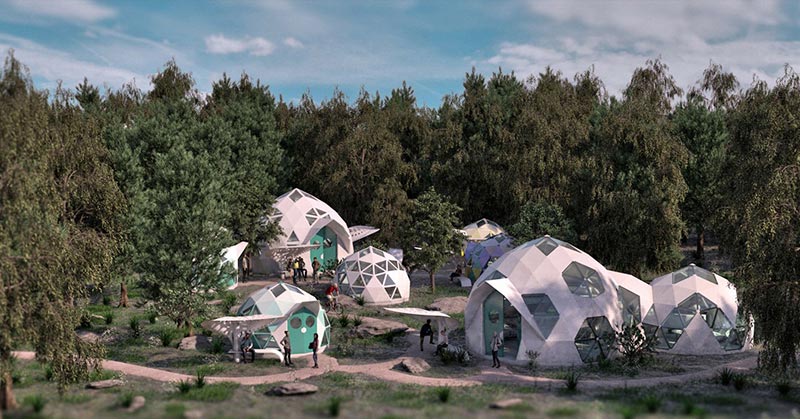There’s a new type of architecture being experimented with that could benefit the environment, help to end homelessness, and last for 500 years. They are known as Geoship homes and they are challenging the traditional idea of what a home should look like.
Geoship Bioceramic Domes
CEO of Geoship Morgan Bierschenk is making waves in the world of construction and architecture. That being said, this is not the first time the dome-shape has challenged the traditional view of a home. (1, 2)
Bierschenk is going off of ideas put forward by American architect Buckminister Fuller who was building dome homes made of wood in the 60s and 70s. He cited the dome shape as having many advantages over rectangular homes, however, the materials he had to build them weren’t right. (1, 2)
Now, roughly 50 years later, we have the right materials to build geodesic domes. This material is a type of material called chemically bonded ceramics. (1, 2)
What are Chemically Bonded Ceramics?
Technically, these are an inorganic polymer. They have many different properties, though one of the most important in house building is that they act like cement, in that from a powder they don’t require heat to be made. This makes it inexpensive and easy to work with.
Previously, these bioceramics have been used in hip and knee replacements. (3)
Read: Bowl-Shaped Roofs Collect Rainwater and Cool House
What Makes Bioceramics So Good for Houses?
There are many reasons why bioceramics are an ideal material to build with (1, 2):
- Can be molded into different shapes
- Durable and durable
- Easy to maintain and repair, if necessary
- The material sequesters more CO2 than is produced during production
- All parts can be made off-site, then brought to the location and assembled
- Fireproof up to 2300 degrees
Why Domes?
The dome design challenges the way we think about the normal home. It allows people to build houses of various sizes, depending on what they need. Additional domes can easily be added as the family grows and changes. (1, 2)
For example, a typical family home will have the largest main dome for shared living space that has an upstairs bedroom or loft. There will be a smaller dome attached as a second bedroom or office, and a third smaller dome attached for a storage room or whatever else the family needs. The dome makes it easier for people to have their own space. (1, 2)
Read: These Amazing Tents Get Solar Power, Can Harvest water and Fold up
Cost
The cost to build a traditional house is usually around $100 to $155 per square foot. This doesn’t include the cost of the land, appliances, and installation, and many of the other aspects required to make it a functioning home. (4)
The Geoship domes, however, the cost ranges from $130 to $160 per square foot. This includes on-site assembly, electrical, appliances, HVAC, cabinets, and more. The total, everything-is-included price can be anywhere from $45,000 to $230,000. The total cost to build a traditional home is $155,310 to $416,250, not including the cost of the land. (1, 2, 4)
Sustainability
These houses can last and be lived in for 500 years with minimal repairs. That in itself makes them more sustainable than a regular home. (1, 2)
The carbon output of making a traditional home versus the geodome, however, is the real win.
“The embodied energy calculations of conventional construction is, …they say somewhere between 80 and 300 tons of embodied CO2 in a typical wood house.” says Bierschenk. “The embodied CO2 in a bioceramic dome is somewhere in the like 3 to 10 ton range and potentially negative when we can actually, in a precast plant you can cure the panels in CO2-rich gas environments and all of that cellular ceramic is a lot of surface area to sequester CO2. So you can kind of, you know, normal CO2 sequestration process might take decades, but we can accelerate that in a precast plant.” (2)
Essentially, these homes not only create less CO2 emissions in their making, but they actually sequester CO2 during the process, so they are carbon-neutral, perhaps even carbon negative. (1, 2)
Helping the Homeless
The first major project for Geoship is to build a permanent geodesic village in Las Vegas for the homeless. Partnered with Amazon-owned retailer Zappos, their ultimate goal is to end homelessness and improve the way we live. (1, 2)
How You Can Get Involved
If you would like to become an investor, you can visit their crowdfunding campaign on Start Engine. The minimum buy-in price is $300. (1, 2)
You can also visit their website for more information.
Keep Reading: This family built a house in the Arctic circle and have been living there since 2013
- https://www.forbes.com/sites/johnkoetsier/2020/04/29/these-carbon-neutral-bioceramic-geodesic-dome-homes-last-500-years-and-dont-burn-or-rust/#20928d5716cc
- https://johnkoetsier.com/will-your-next-home-be-a-bioceramic-geodesic-dome/
- https://www.sciencelearn.org.nz/resources/1776-bioceramics
- https://homeguide.com/costs/cost-to-build-a-house

